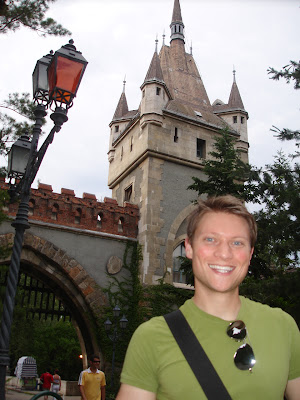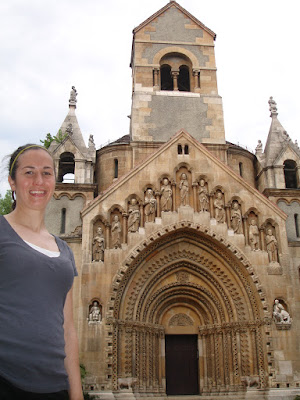 Kate and I traveled to the capital of Hungary for two straight weekends recently, ostensibly to have dental work done on the cheap (as prices are exorbitant here in wicked evil socialist Germany and this was recommended to us by several trustworthy parties). Our dentist appointments were at 9 a.m. on both Monday mornings. But thankfully, we only needed one. Why? Let me show you, you cute little inquisitive bug you.
Kate and I traveled to the capital of Hungary for two straight weekends recently, ostensibly to have dental work done on the cheap (as prices are exorbitant here in wicked evil socialist Germany and this was recommended to us by several trustworthy parties). Our dentist appointments were at 9 a.m. on both Monday mornings. But thankfully, we only needed one. Why? Let me show you, you cute little inquisitive bug you.The first Monday morning should have gone like this:
1) X-rays, exams, cleanings
2) Scheduling next visit (me for fillings; Kate for a crown)
3) $100
4) Handshake
Instead it went like this:
1) X-rays, exams, cleanings
2) No scheduling (I was “fine”; Kate needed a specialist)
3) Free
4) Hug
Don’t ask about numbers three and four. Or even number two (never ask about number two!). All we knew is that, instead of rushing around Budapest like we did the first weekend, trying to see all the sights, we had the second weekend all to ourselves. And it was wonderful. Here’s how it went.
 The first weekend:
The first weekend:After a 10-hour flight delay due to unknown reasons, we arrived in Budapest LATE Saturday night, found our hostel, and slept. We woke up early-ish the next morning determined to cram in a bunch of sights.
This was my second time in Hungary’s capital and Kate’s first. I didn’t remember much about my first time, as it was only a couple hours during a 10-day driving tour of Europe my dad and I took in 2001. I did remember the Hungarian greeting “Servusz,” which is kinda like Aloha in that you can use it for hi and bye and I remembered that the exchange rate was confusingly high.
Our first stop, fittingly, was the ATM, as I didn’t have any Hungarian forints, the funny money used here. So, even though I hadn’t the slightest idea what the exchange rate was, I picked option four of six (75,000 Hungarian forints). It seemed right. And plus, in the States, if you pick the fourth option, it’s usually about $150, right?
(Assuming: 1 = $20; 2 = $60; 3 = $100; 4 = $150; 5 = $200; and 6 = “other”)
Well, my confidence in my memory and ATM protocol was outmatched by my ignorance of Hungary. Almost immediately after passing an exchange booth and seeing about $1 = 200 forints, we did some third grade math and figured that 75,000 forints was $40. Hmm…. we thought. The poverty established by communism must have lasted a little longer here. Things are going to be CHEAP!
So, off we went, eager to spend our monopoly money on an “expensive” breakfast. We stopped at the fanciest place (outdoor seating at Anna Café) on the fanciest pedestrianized strip (Vaci Utca), where we both ordered from the pricey side of the menu: I ordered a “typical” Hungarian dish (FYI – it was huevos rancheros with paprika) and Kate ordered the huevos rancheros with pesto. We were living it up!
 In Hungary, anything with paprika can be called “traditional Hungarian food.” The Hungarians, who call themselves “Magyars” after the tribe of north-central Asians who settled here 1200 years ago and are still the cultural and linguistic ancestors of today's ethnic Hungarians, love paprika. Love it. They got the fever for the stuff when the Turks introduced it right after conquering the poor people. And today, Turks or no Turks, they still put it in everything. Sweet stuff. Salty stuff. If you put it in your mouth, it’s better with paprika. So I was excited to start this day of right.
In Hungary, anything with paprika can be called “traditional Hungarian food.” The Hungarians, who call themselves “Magyars” after the tribe of north-central Asians who settled here 1200 years ago and are still the cultural and linguistic ancestors of today's ethnic Hungarians, love paprika. Love it. They got the fever for the stuff when the Turks introduced it right after conquering the poor people. And today, Turks or no Turks, they still put it in everything. Sweet stuff. Salty stuff. If you put it in your mouth, it’s better with paprika. So I was excited to start this day of right.Anyway, we ate it and loved it and couldn’t be more satisfied with ourselves for being “traditional.” But here’s where it gets stupid.
The waiter brought out the bill and wanted to be paid: 5,800 forints. OK, I thought. Here’s a 10,000. He gave me my change (a 200 forint bill and two 2,000 forint bill) and I thought, what the heck, keep one of the 2,000s. You could use it more than me.
I then excused myself to go to the bathroom, where I realized I have given the waiter a $10 tip. Wait a second, I thought. If we only got $40 out of the ATM and I just gave the waiter a $10 tip, then…(gerbil on hamster wheel….) I actually got $400 out of the bank! WHAT?! (Here’s me figuring it out)
 After getting over the frustration of being so incompetent with money, I got a grip on life and decided that we’d better start spending this money – because if there’s anything I hate more than spending money, it’s playing exchange booth pachinko, where the house rules say you automatically lose 5-10% just for playing.
After getting over the frustration of being so incompetent with money, I got a grip on life and decided that we’d better start spending this money – because if there’s anything I hate more than spending money, it’s playing exchange booth pachinko, where the house rules say you automatically lose 5-10% just for playing.So we started enjoying ourselves. Budapest was actually two cities once upon a time: Buda, on the white-collar, Habsburg-loved, hilly side of the Danube, complete with a castle and a citadel, and Pest, on the flat, blue-collar, Turk- and Slav-loved side of the Danube. The Magyar people (who were taken over by and integrated with the Huns in the 1200s and still love to name their kids Atilla to this day) combined the two cities in the late 1800s and made it the capital of Hungary. Their language is not related to anything in the area, so it’s really quite an interesting and foreign place….with lots to explore.
Our first stop was the second largest synagogue in the world (and the largest one in Europe thanks to donations from the largest Jewish community still existing in Europe).
 We then walked along the Danube and caught a nice glimpse of the parliament.
We then walked along the Danube and caught a nice glimpse of the parliament.  Afterward we enjoyed walking around the Fisherman’s Bastion area of town, perched high above the river, near the castle.
Afterward we enjoyed walking around the Fisherman’s Bastion area of town, perched high above the river, near the castle. 
 We then crossed the river again and headed for Heroes’ Square, a large pedestrian square with really not much going on.
We then crossed the river again and headed for Heroes’ Square, a large pedestrian square with really not much going on.  And ended up in a large and beautiful park.
And ended up in a large and beautiful park.

 Finally, as it is festival season in Europe, we bumbled upon a wine fest and enjoyed the local specialties, including wine, paprika vegetables, and this curious-looking and popular dessert, the Hungarian sweet log, which is basically dough wrapped in a layer of cinnamon-sugar and walnuts.
Finally, as it is festival season in Europe, we bumbled upon a wine fest and enjoyed the local specialties, including wine, paprika vegetables, and this curious-looking and popular dessert, the Hungarian sweet log, which is basically dough wrapped in a layer of cinnamon-sugar and walnuts.
Then, since we had a dentist appointment the next morning, we then called it a night. 

1 comment:
Great Post Justin, very witty. Enjoy your "Bachelordom."
Post a Comment